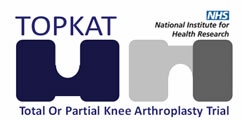Late-stage medial compartment knee osteoarthritis (OA) can be treated using total knee replacement (TKR) or partial (unicompartmental) knee replacement (PKR). It is not known which replacement offers most benefit for the patient or for the health-care system.
TOPKAT was designed as a multicentre parallel-group superiority randomised controlled trial (RCT) to evaluate the clinical effectiveness and cost-effectiveness of TKR compared with PKR (unicompartmental) for medial compartmental OA. The trial used a novel combined equipoise/expertise approach (hybrid expertise-based design). The expertise-based design component was included to help address some of the known challenges of conducting a RCT of skilled-based interventions, such as clinician preference for one intervention over another. Use of this design helped to maximise surgeon participation in the study and negate known obstacles arising from clinician preference, a feature that was observed in an earlier attempt to evaluate the differences between PKR and TKR. No specified brand or subtype of implant was investigated. It was impractical to blind patients and surgeons to treatment allocation. However, clinical evaluators were masked from treatment allocation where practical.
The Oxford Knee Score at 5 years was the primary end point. Secondary outcomes included activity scores, global health measures, transition items, patient satisfaction (Lund Score) and complications (including reoperation, revision and composite ‘failure’ – defined by minimal Oxford Knee Score improvement and/or reoperation). Cost-effectiveness was also assessed.
A total of 528 patients with medial compartment knee osteoarthritis from 27 hospitals (involving 68 experienced surgeons) from across the UK were randomised (PKR, n = 264; TKR, n = 264). The follow-up primary outcome response rate at 5 years was 88% and both operations had good outcomes. There was no significant difference between groups in mean Oxford Knee Score at 5 years (difference 1.04, 95% confidence interval –0.42 to 2.50). An area under the curve analysis of the Oxford Knee Score at 5 years showed benefit in favour of PKR over total knee replacement, but the difference was within the minimal clinically important difference [mean 36.6 (standard deviation 8.3) (n = 233), mean 35.1 (standard deviation 9.1) (n = 231), respectively]. Secondary outcome measures showed consistent patterns of benefit in the direction of PKR compared with TKR although most differences were small and non-significant. Patient-reported improvement (transition) and reflection (would you have the operation again?) showed statistically significant superiority for PKR only, but both of these variables could be influenced by the lack of blinding. The frequency of reoperation (including revision) by treatment received was similar for both groups: 22 out of 245 for PKR and 28 out of 269 for TKR participants. Revision rates at 5 years were 10 out of 245 for PKR and 8 out of 269 for TKR. There were 28 ‘failures’ of PKR and 38 ‘failures’ of TKR (as defined by composite outcome). Beyond 1 year, PKR was cost-effective compared with TKR, being associated with greater health benefits (measured using quality-adjusted life-years) and lower health-care costs, reflecting lower costs of the index surgery and subsequent health-care use.
Good outcomes and relatively few complications were observed after both operations. The measurements taken to assess the clinical benefit were largely very similar between the two groups. Where differences did occur at 5 years, there were only small differences between the two knee replacements and PKR was generally favoured. Some measurements, however, did show a larger difference between the two groups, including whether or not the operation addressed the patients’ problems and whether or not the patient would have the operation again. These measurements were also in favour of PKR, but caution is required not to overstate importance, as participants in the study knew which device they had had implanted. The number of participants requiring further operations or revision surgery was similar in the two groups. This last finding contrasts with information from previously obtained, mainly non-randomised, studies and is of high relevance. The cost of each operation in relation to the benefit obtained was clearly in favour of PKR.
Both PKR and TKR are effective, offer similar clinical outcomes and have similar reoperation and complication rates. Some patient-reported measures of treatment approval were significantly higher for PKR than for PKR. Partial knee replacement was more cost-effective (more effective and cost saving) than TKR at 5 years.
We are undertaking further (10-year) follow-up to assess the longer-term stability of these findings.
The full TOPKAT report is available here - https://www.journalslibrary.nihr.ac.uk/hta/hta24200/#/full-report


